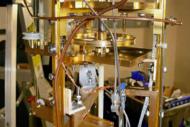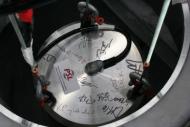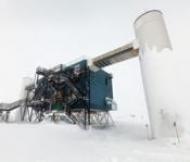The Maruyama group is exploring several topics in nuclear and particle astrophysics, ranging from studying properties of neutrinos to a search for dark matter. We are carrying out experiments to search for the identity of dark matter, in particular, axions with HAYSTAC, ALPHA, and RAY. We are also looking for a process called neutrinoless double beta decay with CUORE, currently taking data, and building the next experiment called CUPID. Discovering neutrinoless double beta decay would provide a clue to the matter-antimatter asymmetry in the universe.
Professor Maruyama is also involved in the COSINE-100 experiment to test DAMA/LIBRA collaboration’s assertion that they have detected dark matter, and the IceCube Neutrino Observatory. She is no longer taking students on those experiments.
 |
Axion Searches: HAYSTAC (Haloscope At Yale Sensitive To Axion CDM), ALPHA, and RAY are looking for dark matter in the form of Axions, which are very low mass particles that are predicted in the context of the standard model of electroweak interactions (quark, gluon, W, Z, Higgs, etc. are all part of this model). If they do indeed exist and form dark matter, they will convert to radiofrequency photons in the presence of a strong magnetic field. The photon energy, hence frequency, is essentially determined by the axion mass. The heart of our experiment is a tunable radiofrequency (microwave) cavity resonator, which serves to build up the axion signal, and a quantum-limited amplifier based on the Josephson effect, which occurs when Cooper pairs tunnel through an insulating layer separating two superconductors. |
 |
WIMP Dark Matter Searches: COSINE-100 is a dark matter experiment located in South Korea. The experiment has recently moved a new underground lab at Yemilab, and has been upgraded to COSINE-100U. COSINE-100 took data from 2016 – 2023, and COSINE-100U started taking data in 2025. The detectors are made of NaI(Tl) (sodium-iodide), with the original aim of testing the DAMA Collaboration’s claim that they have made a direct detection of dark matter with their thallium-doped sodium iodide detectors. With this goal accomplished, the experiment will continue to collect data to test smaller cross sections and lower masses, as well as other dark matter models. |
 |
Neutrinoless Double Beta Decay: CUORE (meaning “heart” in Italian) stands for “Cryogenic Underground Observatory for Rare Events”. Located at the Gran Sasso National Underground Laboratory in Italy, the main goal of the experiment is to look for a process called neutrinoless double beta decay. If such a process is observed, it would mean that neutrinos are their own antiparticles and may hold the clue to why we live in a Universe of matter, and not antimatter. With CUORE, we can also look for dark matter and annual modulation signals. CUORE@Yale / Official CUORE Site CUPID: We are currently actively involved in R&D and development of the follow-up experiment to CUORE, aptly called CUPID. CUPID stands for “CUORE Upgrade with Particle IDentification,” with particle identification providing better background rejection capability and more sensitive measurement of neutrinoless double beta decay. |
 |
WIMP Dark Matter: DM-Ice is searching for dark matter in the southern hemisphere. The goal is to perform a search for dark matter using the time variation resulting from the motion of the detector relative to the dark matter halo as a signature. The Antarctic ice offers a clean environment to conduct a dark matter experiment, complete with scientific infrastructure provided by the NSF South Pole Station. If confirmed, the observation would revolutionize our understanding of particle physics and cosmology. 17 kg of thallium-doped sodium iodide detectors have been running at the South Pole since 2011. While the detector is still in operation, Professor Maruyama is no longer taking students for this experiment. |
 |
Neutrino Astrophysics: The IceCube Neutrino Observatory. The IceCube Neutrino Detector is a neutrino telescope that was completed in February 2011 at the South Pole. IceCube uses deep Antarctic ice instrumented with 5,160 photomultiplier tubes (PMTs) at depths between 1,450 and 2,450 meters. The main goal of the experiment is to detect neutrinos in the high-energy range, spanning from 1011 eV to about 1021 eV. Prof. Maruyama’s focus is on low energies. IceCube can also detect 10 MeV neutrinos coming from nearby supernovae. We study how supernovae explode as well as fundamental properties of neutrinos (theta-13, mass hierarchy, etc.). With the addition of DeepCore, we can study ~100 GeV neutrinos to study atmospheric neutrino oscillation and dark matter collected in the Sun, Earth, and the Galactic Center. The addition of PINGU would bring the energy threshold down to 10 GeV. While the experiment continues to produce many exciting results, Prof. Maruyama is currently not taking students for IceCube. |
